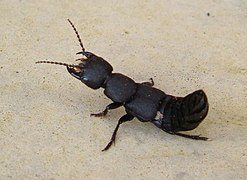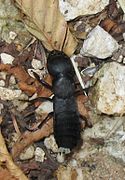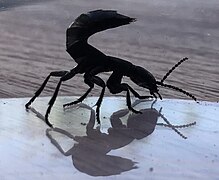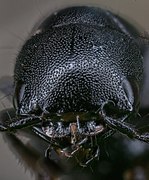
Beetles are insects that form the order Coleoptera, in the superorder Holometabola. Their front pair of wings are hardened into wing-cases, elytra, distinguishing them from most other insects. The Coleoptera, with about 400,000 described species, is the largest of all orders, constituting almost 40% of described insects and 25% of all known animal species; new species are discovered frequently, with estimates suggesting that there are between 0.9 and 2.1 million total species. Found in almost every habitat except the sea and the polar regions, they interact with their ecosystems in several ways: beetles often feed on plants and fungi, break down animal and plant debris, and eat other invertebrates. Some species are serious agricultural pests, such as the Colorado potato beetle, while others such as Coccinellidae eat aphids, scale insects, thrips, and other plant-sucking insects that damage crops. Some others also have unusual characteristics, such as fireflies, which use a light-emitting organ for mating and communication purposes.

The rove beetles are a family (Staphylinidae) of beetles, primarily distinguished by their short elytra that typically leave more than half of their abdominal segments exposed. With over 66,000 species in thousands of genera, the group is the largest family in the beetle order, and one of the largest families of organisms. It is an ancient group, with fossilized rove beetles known from the Triassic, 200 million years ago, and possibly even earlier if the genus Leehermania proves to be a member of this family. They are an ecologically and morphologically diverse group of beetles, and commonly encountered in terrestrial ecosystems.
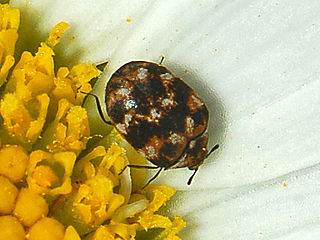
The varied carpet beetle is a 3 mm-long beetle belonging to the family Dermestidae, positioned in subgenus Nathrenus. They are a common species, often considered a pest of domestic houses and, particularly, natural history museums, where the larvae may damage natural fibers and can damage carpets, furniture, clothing, and insect collections. A. verbasci was also the first insect to be shown to have an annual behavioral rhythm and to date remains a classic example of circannual cycles in animals.
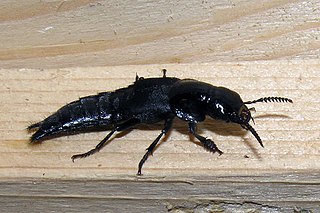
Velleius dilatatus, the hornet rove beetle, is a species of rove beetle belonging to the family Staphylinidae. This beetle is commensal with the European hornet, living in its nests.

Creophilus maxillosus, the hairy rove beetle, is a species of rove beetle.

The pictured rove beetle is a wingless rove beetle which lives on the sandy beaches of the West Coast of the United States from southern Alaska to Baja California. It is nocturnal, emerging at night from temporary sand burrows to feed on beach hoppers (Orchestoidea).

Callipogon relictus is a species of longhorn beetle which is mostly found in Korea, but also in China and southern part of Russian Far East. It inhabits mixed and deciduous forests. The population of Callipogon relictus is decreasing due to deforestation and uncontrolled collection, and therefore the species are listed in the Russian Red Book.

Drilus flavescens is a species of beetle belonging to the family Drilidae.

Lebia grandis is a ground beetle in the family Carabidae found in North America. It is a specialist predator on the eggs and larvae of Colorado potato beetles, and its larvae are obligate parasitoids of Colorado potato beetle pupae.

Meloe violaceus, the violet oil beetle, is a species of oil beetle belonging to the family Meloidae subfamily Meloinae.

Ocypus ophthalmicus is a species of rove beetle belonging to the family Staphylinidae, subfamily Staphylininae.
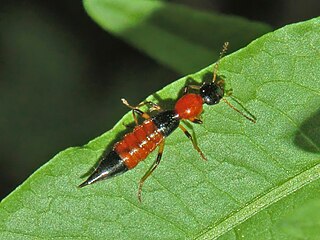
Paederus baudii is a species of rove beetle belonging to the family Staphylinidae subfamily Paederinae.

The Brachypsectridae are a family of beetles commonly known as the Texas beetles. There are only two extant genera, Brachypsectra and Asiopsectra. Brachypsectra has a cosmopolitan distribution, mostly in arid regions, while Asiopsectra is found in Central Asia and the Middle East.

Staphylininae are a subfamily of rove beetles. They contain the typical rove beetles with their long but fairly robust blunt-headed and -tipped bodies and short elytra, as well as some more unusually-shaped lineages.

Ocypus is a genus of rove beetles in the subfamily Staphylininae.

Tillus elongatus is a species of beetle in the family Cleridae. It is found in the Palearctic. The “Holz” in the German common name Holzbuntkäfer indicates that these checkered beetles are found in wood. Although Tillus elongatus can reach up to a size of 1 cm long, the beetle is rarely seen by humans, as it primarily resides hidden in the wood of trees. The colouration of the males differs from that of the females.

Rugilus rufipes is a species of rove beetle in the family Staphylinidae. It is commonly found across Europe and parts of North America. These beetles are known for their slender bodies and distinctive red legs, which give the species its name.

Habroscelimorpha dorsalis, commonly known as the eastern beach tiger beetle, is a species of flashy tiger beetle in the family Cicindelidae. It is found in Central America and North America.
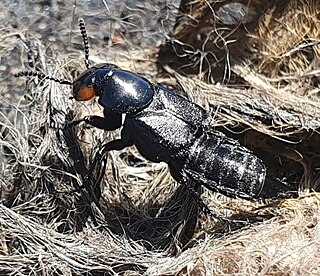
Creophilus oculatus or devil's coach horse is a species of large carrion-feeding rove beetle endemic to New Zealand.

Rhantus suturalis, commonly known as the supertramp beetle or cosmopolitan diving beetle, is a species of diving beetle (Dytiscidae) with a cosmopolitan distribution.


